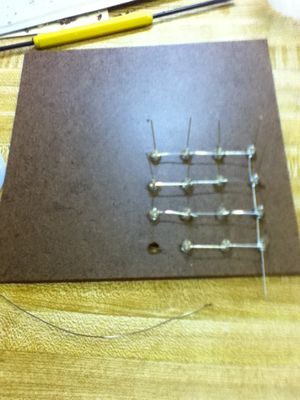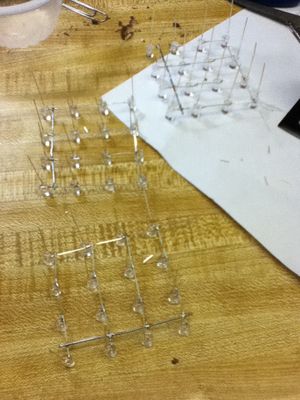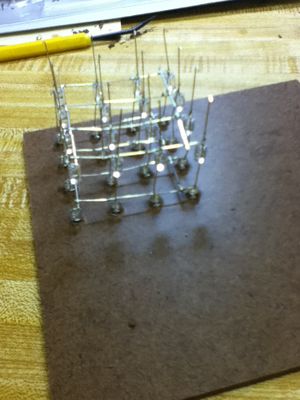Difference between revisions of "Ed Powell"
From WLCS
| Line 10: | Line 10: | ||
'''Progress:''' | '''Progress:''' | ||
| − | * All of the necessary parts to learn the instruction set for the | + | * All of the necessary parts to learn the instruction set for the micro-controller and build the cube have been purchased (see list below) - ✓ |
| − | * The C Programming | + | * The C Programming website tutorials have been completed and a program for each section has been made - ✓ |
** Two sections should be done during each class | ** Two sections should be done during each class | ||
| − | ** Sections | + | ** Sections completed during the last class should be reviewed to ensure that its not forgotten |
* Tutorials have been found that explain the programming process sufficiently (links to tutorials will be posted as they're found) - Ongoing | * Tutorials have been found that explain the programming process sufficiently (links to tutorials will be posted as they're found) - Ongoing | ||
| − | * Start working with the micro-controller understand how it works | + | * Start working with the micro-controller understand how it works - ✓ |
| − | ** The breadboard should be used so | + | ** The breadboard should be used so circuits can be made, tested, and then disassembled |
| − | ** A blink LED program has been executed - | + | ** A blink LED program has been executed - Ongoing |
| − | *** Multiple programs has been loaded onto the | + | *** Multiple programs has been loaded onto the micro-controller successfully but the LED doesn't blink |
* All of the necessary parts to build the cube have been purchased (see list below) - ✓ | * All of the necessary parts to build the cube have been purchased (see list below) - ✓ | ||
| − | * All parts have been soldered onto the proto-board and the | + | * All parts have been soldered onto the proto-board and the circuitry has been wired - Ongoing |
** The LEDs have been bent, soldered into layers, and and soldered together into their final cubic form (see Pictures 1 and 2) | ** The LEDs have been bent, soldered into layers, and and soldered together into their final cubic form (see Pictures 1 and 2) | ||
** The remaining parts have been soldered to the proto-board | ** The remaining parts have been soldered to the proto-board | ||
** The finished LED cube has been soldered to the proto-board | ** The finished LED cube has been soldered to the proto-board | ||
| − | ** The | + | ** The circuitry has been wired and the micro-controller is ready to be programmed |
| − | * The C Programming | + | * The C Programming website tutorials have been completed and a program for each section has been made - ✓ |
* Tutorials have been found that explain the programming process sufficiently - ✓ | * Tutorials have been found that explain the programming process sufficiently - ✓ | ||
** The tutorials have been finished - Ongoing | ** The tutorials have been finished - Ongoing | ||
Revision as of 12:21, 17 June 2011
Proposal
Description:
- A single LED cube will be built using an ATmega 16 to control it
- The ATmega 16 will be programmed with C using AVR Studio and an AVRISP MKII to load the program onto the micro-controller
- The instruction set to program the micro-controller will be learned from the PDFs available on Atmel's website and from other linked websites
- A breadboard will be used to aid in learning the instruction set and to ease programming
- An ATmega 168 will be used in addition to the ATmega 16 while the instruction set is being learned
Progress:
- All of the necessary parts to learn the instruction set for the micro-controller and build the cube have been purchased (see list below) - ✓
- The C Programming website tutorials have been completed and a program for each section has been made - ✓
- Two sections should be done during each class
- Sections completed during the last class should be reviewed to ensure that its not forgotten
- Tutorials have been found that explain the programming process sufficiently (links to tutorials will be posted as they're found) - Ongoing
- Start working with the micro-controller understand how it works - ✓
- The breadboard should be used so circuits can be made, tested, and then disassembled
- A blink LED program has been executed - Ongoing
- Multiple programs has been loaded onto the micro-controller successfully but the LED doesn't blink
- All of the necessary parts to build the cube have been purchased (see list below) - ✓
- All parts have been soldered onto the proto-board and the circuitry has been wired - Ongoing
- The LEDs have been bent, soldered into layers, and and soldered together into their final cubic form (see Pictures 1 and 2)
- The remaining parts have been soldered to the proto-board
- The finished LED cube has been soldered to the proto-board
- The circuitry has been wired and the micro-controller is ready to be programmed
- The C Programming website tutorials have been completed and a program for each section has been made - ✓
- Tutorials have been found that explain the programming process sufficiently - ✓
- The tutorials have been finished - Ongoing
- The programming of the main program has been started -
- The cube has been tested -
Pictures of Progress:
Parts:
- The following parts will be used:
- Atmel Atamega16 micro-controller
- Programmer for the micro-controller
- Protoboard
- 64 green LEDs
- 1 red status LED
- 16 220 ohm resistors for LEDs
- 2 470 ohm resistors
- 1 10k resistor
- 4 2.2 k resistors
- 4 2N2222 transistors
- 6 0.1uF ceramic capacitors
- 2 22pF ceramic capacitors
- 1 14.7456 MHz crystal
- 2 tactile buttons
- 40 pin connector for micro-controller
- A spare usb cable (for power)
- Un-used/Replaced Parts:
- Build a single color LED cube using the following parts:
- 1x 10uF capacitor
- 1x 1000uF capacitor
- 6x 0.1uF ceramic capacitor
- 2x 22pF ceramic capacitor
- 1x crystal 14.7456 MHz
- 2x tactile button
- Optional power switch
- Connector for 12v power
- Optional connector for 5v power
Links:
- Links are added in the order they were found
- 4x4x4 LED Cube Instructable
- RGB LED Cylinder
- Think Geek Cube Available to Buy
- RGB LED Cube Story
- RGB LED Cube Story Cube For Sale
- 8x8x8 RGB LED Cube
- RGB LED Cube Directions
- RGB LED 4x4x4 Cube Directions
- C programming Tutorials
- Installing the Software on the Micro-Controller
- 5x5x5 LED Cube Instructable
- ATmega16 Programming Guide
- ATmega Architecture Guide
- ATmega32 Programming Guide
- AVR Programming Guide
- AVR C Programming Guide
- [http://www.atmel.com/dyn/resources/prod_documents/doc2466.pdf ATmega 16 Data Sheet
- ATmega 168 Blink LED Tutorial
- ATmega 168 Data Sheet
- Parallel Port Programmer Cable
- Data Sheet for AVRISP MKII
- AVRISP MKII Help
2nd Quarter Proposal
Description:
- Continue working on the 1st quarter project by learning C to program the micro-controller
- There will be more websites used this quarter with more concise information on programming the micro-controller
- If more websites are found during the quarter they will be added to this page
- Description from the previous quarter should be read for more information on the project
- Two books (C for Unix and C++ for You++) will also be used along with the websites to help accomplish this task
- The goals and deadlines may be altered if more resources are found during the quarter
- There will be more websites used this quarter with more concise information on programming the micro-controller
Resources and Information:
- Installing the Software on the Micro-Controller
- 5x5x5 LED Cube Instructable
- ATmega16 Programming Guide
- ATmega Architecture Guide
- ATmega32 Programming Guide
- AVR Programming Guide
- AVR C Programming Guide
Progress:
- Work through all steps in the C Programming website - ✓
- After each step is competed a program containing what was learned should be written - ✓
- Work through all of the steps in the ATmega16 programming guide by 12/6/10
- Two steps of the guide should be done per class period
- What was learned the last class period should be reviewed the next class period so it is not forgotten
- Start working with the micro-controller by installing and running beginner programs to understand how it works
- The tutorials above should be used to learn how to program the controller
- The installation and testing will only be done at home but the code may be written at school
- A separate board may be created for this purpose
Progress:
- The C Programming website has been completed and program files for each section have been written - ✓
- The parts necessary to build the cube have been ordered or gotten - ✓
1st Quarter Proposal:
Description:
- Build a single color LED cube using the following parts:
- Acrylic Case
- Protoboard (the type with copper circles)
- Atmel AVR Atamega16 micro-controller
- Programmer to program the Atmega16
- 64 LEDs
- 2 status LEDs
- Max232 rs-232 chip, or equivalent
- 16 resistors for LEDs
- 2x resistor 470 ohm
- 1x resistor 10k
- 4x resistor 2.2k
- 4x NPN transistor BC338
- 1x 10uF capacitor
- 1x 1000uF capacitor
- 6x 0.1uF ceramic capacitor
- 2x 22pF ceramic capacitor
- 1x crystal 14.7456 MHz
- 2x tactile button
- Optional power switch
- Connector for 12v power
- Optional connector for 5v power
- Learn C to program the micro-controller using the C Programming Guide
Resources and Information:
- 4x4x4 LED Cube Instructable
- LEDs
- RGB LED Cylinder
- Think Geek Cube Available to Buy
- RGB LED Cube Story
- RGB LEDs
- RGB LED Cube Story Cube For Sale
- 8x8x8 RGB LED Cube
- RGB LED Cube Directions
- RGB LED 4x4x4 Cube Directions
- C Programming Guide
Progress:
- Acquire all parts necessary for the cube by 10/1/10
- Solder parts on to the protoboard by 10/7/10
- Bend and attach all LEDs to the board by 10/14/10
- Finish assembling the cube by 10/15/10
- Learn C by 10/21/10
- Program the micro-controller by 11/1/10
Possible Later Goal:
- Build an RGB LED cube after the single color cube is finished using the following parts (if deemed possible):
- Acrylic Case
- H4C printed circuit board
- 110VAC to 9VDC 300mA transformer
- 22 AWG straightened galvanized soft steel wire x40
- Diffuse common-cathode RGB LED x64
- PIC18F4620 micro-controller (40 pins)
- SN74AHC574 octal D-type flip-flop x4 (20 pins)
- ULN2803A NPN Darlington transistor array (18 pins)
- LM2574 5V switching regulator (8 pins)
- 22 resistor array (16 pins)
- 47 resistor array (16 pins)
- 68 resistor array (16 pins)
- 47K resistor x3 (yellow-violet-orange-gold)
- 1K resistor x5 (brown-black-red-gold)
- 1N4148TR signal diode x24 (red)
- 511-BAT48 rectifier diode (blue)
- 330mH inductor
- 0.1uF ceramic capacitor x5
- 10uF electrolytic capacitor
- 22uF electrolytic capacitor
- 220uF electrolytic capacitor
- 6” black wire
- 18” red wire
- 24” white wire
- 2.1mm DC power jack
- Toggle switch
- Momentary toggle switch x2
- 1” threaded standoff x4
- 1⁄2” 4-40 screw x8
- Rubber feet x4
- DLP-UB232R UART-USB bridge module
- Mini-B USB cable


